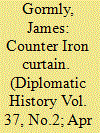| Srl | Item |
| 1 |
ID:
137146


|
|
|
|
|
| Summary/Abstract |
More than a decade after the European Court of Justice’s “open skies” judgments, is the European Union (EU) now capable of asserting a leading role in the international aviation regime? This article approaches the EU’s external aviation policy through the lenses of role theory and, more precisely, through the threefold connotation of the concept of role: role conceptions, role expectations, and role performance. It finds that there is a converging tendency between the three dimensions and that the gap between external expectations and actual policy behaviour on the one hand, and the EU’s aspiration for a leading role in international aviation on the other, is diminishing. Over time, then, the EU could indeed transform from a regional trendsetter into a leading player in the international aviation regime.
|
|
|
|
|
|
|
|
|
|
|
|
|
|
|
|
| 2 |
ID:
123837


|
|
|
|
|
| Publication |
2013.
|
| Summary/Abstract |
American aviation relations with the Soviet Union and Eastern Europe followed an almost a predicable path. Initially, there was optimism that the Soviets would join the West in a system of international aviation. This matched the needs of an expanding aviation industry and the hopes of continuing East-West cooperation. But, continued Soviet refusal to open its air space and the developing cold war encouraged Washington to focus its efforts on Eastern Europe, seeing it as a means to maintain a wedge in the Iron Curtain. But by mid-1948 events in Czechoslovakia produced a new approach, the isolation of Soviet and Eastern bloc aviation behind the Iron Curtain. Convincing Western European nations to agree was like herding cats, but most grudgingly complied. The "success" of the "counter iron curtain" lasted until the mid-1950s, when changes in Soviet aviation policy lured most European nations away from U.S. policy. As governments flocked to Moscow jockeying for air routes, Washington's goal of isolation collapsed, leaving its policy a captive of the Cold War until 1967.
|
|
|
|
|
|
|
|
|
|
|
|
|
|
|
|
| 3 |
ID:
088051


|
|
|
|
|
| Publication |
2009.
|
| Summary/Abstract |
International aviation is growing rapidly, resulting in rising aviation greenhouse gas emissions. Concerns about the growth trajectory of the industry and emissions have led to calls for market measures such as emissions trading and carbon levies to be introduced to restrict demand and prompt innovation. This paper provides an overview of the science on aviation's contribution to climate change, analyses key trends in the industry since 1990, projects international civil aviation emissions to 2025 and analyses the emission intensity improvements that are necessary to offset rising international demand. The findings suggest international aviation carbon dioxide (CO2) emissions will increase by more than 110 per cent between 2005 and 2025 (from 416 Mt to between 876 and 1013 Mt) and that it is unlikely emissions could be stabilised at levels consistent with risk averse climate targets without restricting demand.
|
|
|
|
|
|
|
|
|
|
|
|
|
|
|
|